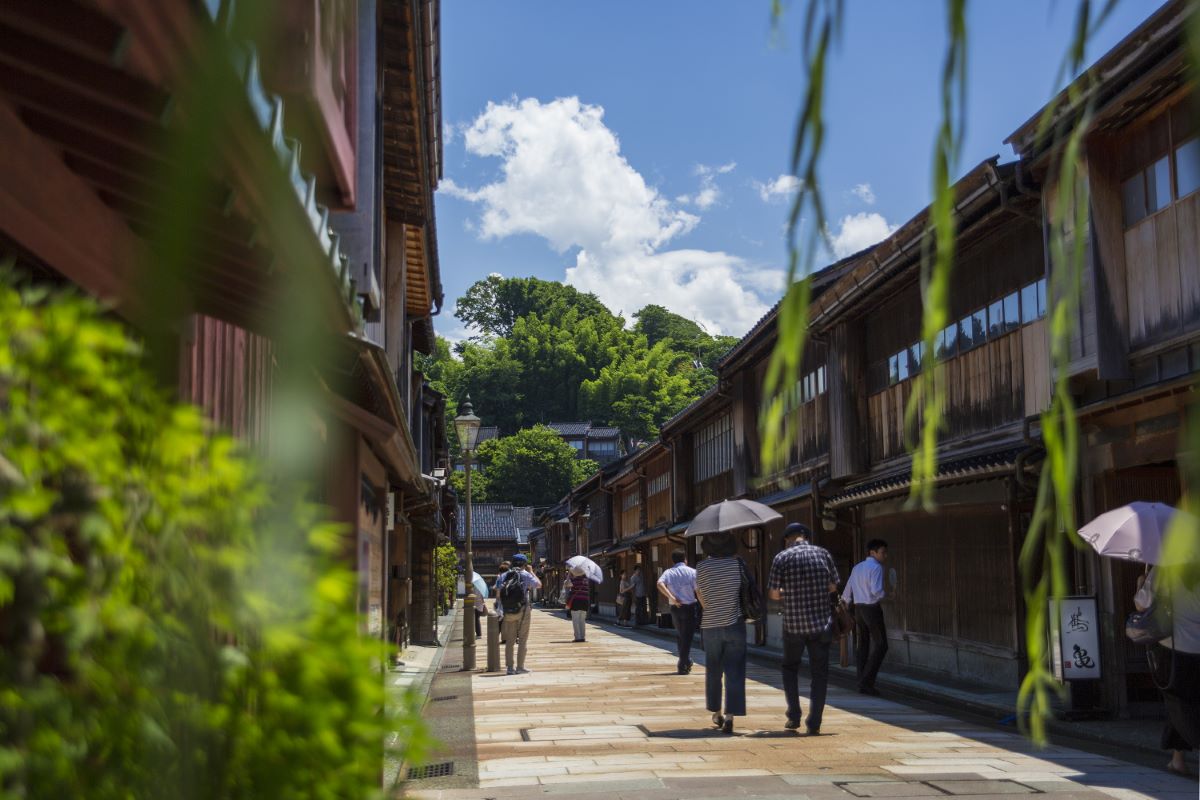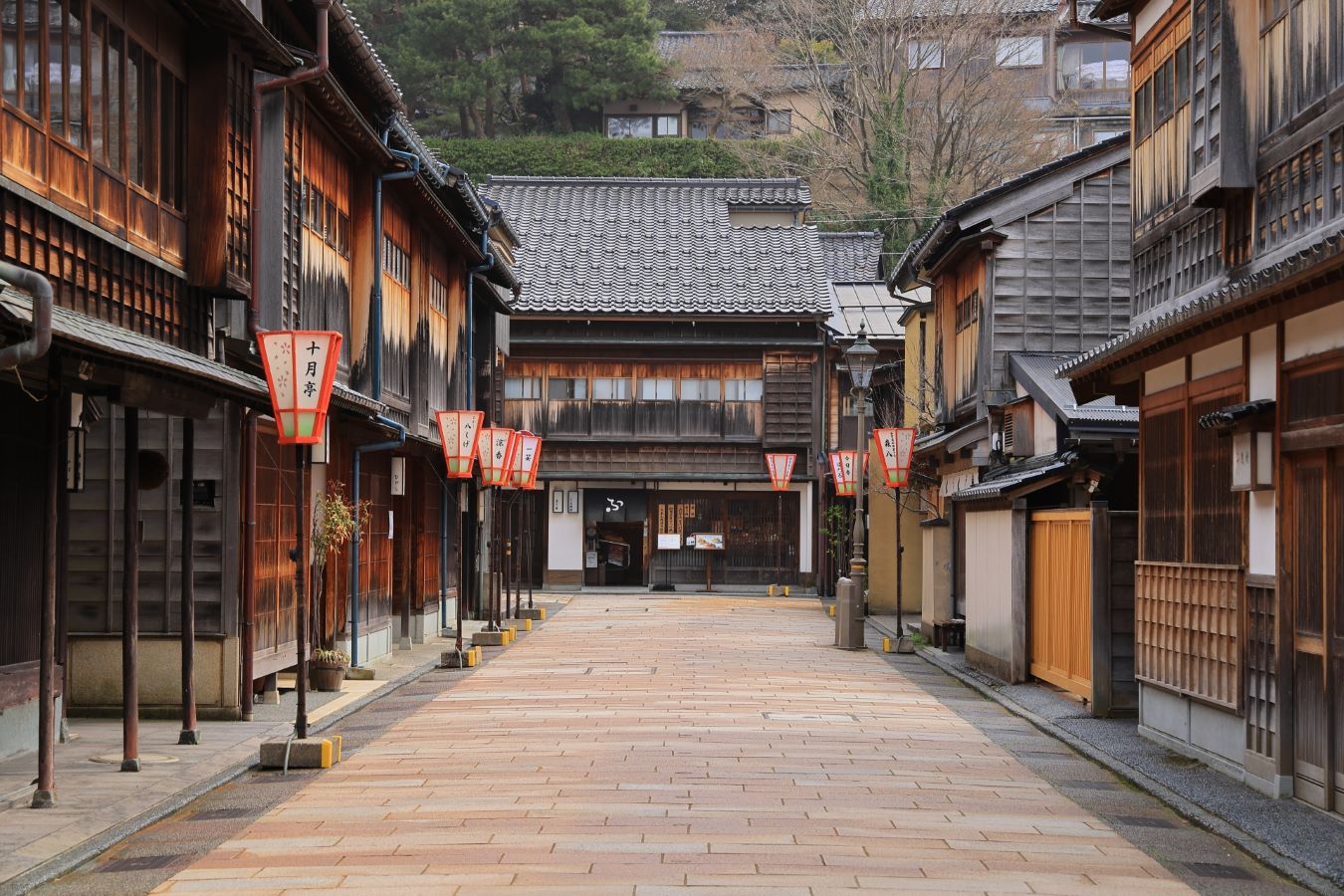Higashi Chaya District is a charming and historic area in Kanazawa, a city on the west coast of Japan.

The district is known for its well-preserved traditional architecture, which dates back to the Edo period.
Higashi Chaya is one of three chaya districts in Kanazawa and is by far the largest and most popular among tourists.

Walking through Higashi Chaya feels like stepping back in time. The narrow streets are lined with beautifully preserved wooden buildings, many of which house traditional tea houses where geisha entertain guests with music, dance, and conversation.

You can also explore shops selling local crafts and souvenirs, or stop by one of the district’s museums to learn more about its rich history.
Location

The Higashi Chaya District is on the eastern bank of the Asano River, which runs through the center of Kanazawa. The district is situated on a hillside, with narrow streets lined with traditional wooden buildings. The area is known for its well-preserved Edo-period architecture, which includes teahouses, shops, and restaurants.
The district is also home to the Shima Geisha House, which is one of the few remaining geisha houses in Kanazawa. The house has been preserved as a museum, and you can learn about the history and culture of geisha in Kanazawa.
History

The District in Kanazawa is a historic entertainment district that has been a popular destination for many years. The district has a rich history that spans centuries, and it is one of the few places in Japan where you can experience the traditional Japanese tea house culture.
Established during the Edo period, which lasted from 1603 to 1868. The district was originally home to tea houses that were frequented by wealthy merchants and samurai. The tea houses were built in the traditional Japanese style, with wooden facades and paper lanterns that illuminated the streets at night.
Development
During the Meiji period, which lasted from 1868 to 1912, the Higashi Chaya District continued to thrive as a center of entertainment and culture. Many of the tea houses in the district were renovated and expanded, and new tea houses were built to accommodate the growing number of visitors. The district became known for its geisha performances, which were a popular form of entertainment at the time.
Decline
The District experienced a decline in the mid-20th century as Japan modernized and traditional forms of entertainment fell out of favor. Many of the tea houses in the district closed down, and the area fell into disrepair. However, in the 1980s, the district was designated as an Important Traditional Building Preservation Area, and efforts were made to restore the tea houses and revitalize the area. Today, the Higashi Chaya District is a popular destination that attracts visitors from all over the world.
Architecture

The architecture of Higashi Chaya District is a beautiful representation of traditional Japanese design. The area is known for its well-preserved buildings that have been standing for centuries. The buildings are made of wood and have a distinct look that is unique to the region.
Traditional Buildings
One of the most iconic buildings in Higashi Chaya District is the teahouse. These traditional buildings were used for tea ceremonies and are still in use today. The teahouses have a simple yet elegant design that is meant to create a calm and peaceful atmosphere. The buildings have sliding doors that can be opened to let in fresh air and natural light.
Another type of building that can be found in Higashi Chaya District is the machiya. These buildings were used as both a residence and a workplace. The first floor was used for business, while the upper floors were used as living quarters. The buildings have a narrow frontage and a deep interior, which was designed to maximize the limited space available in the city.
Design Elements
The buildings in Higashi Chaya District are known for their intricate design elements. The buildings have decorative features, including latticework, carvings, and paintings. The latticework is particularly noteworthy, as it was used to create intricate patterns that are both functional and beautiful. The patterns were designed to provide privacy and shade while still allowing natural light to enter the building.
The buildings in Higashi Chaya District also feature roof styles. The most common type of roof is the gabled roof, which has two sloping sides. The roofs are made of thatch or tiles and are designed to withstand heavy snowfall. The buildings also have eaves that extend out from the roof, which provide shade and protection from the rain.
Culture

The Higashi Chaya District is not just a beautiful place to visit but also a cultural hub that offers a glimpse into traditional Japanese culture. You can experience the following cultural aspects:
Teahouses
The Higashi Chaya District is famous for its teahouses, which offer visitors a chance to experience the traditional Japanese tea ceremony. You can enjoy a cup of matcha tea while admiring the beautiful architecture and decor of the teahouses. Some of the most popular teahouses in the district include Kaikaro Teahouse, Shima Teahouse, and En Teahouse.
Performances
You can also enjoy traditional Japanese performances in the Higashi Chaya District. The district is home to geisha houses, where you can watch geishas perform traditional dances and music. The performances are accompanied by traditional Japanese instruments such as shamisen, koto, and shakuhachi. Some of the most popular geisha houses in the district include the Ochaya Shima and Ochaya Wakamatsu.
Attractions

The main attraction of Higashi Chaya District is the historic teahouses, which were once frequented by geishas. You can tour the teahouses and learn about their history and significance. Some of the most popular teahouses include Shima, Kaikaro, and Ochaya Shima.
In addition to the teahouses, you can also explore the area’s temples and shrines, such as the Utasu Shrine and the Daijoji Temple. These sites offer a glimpse into the region’s religious traditions and cultural practices.
Activities
One of the most popular activities in Higashi Chaya District is attending a traditional Japanese tea ceremony. You can participate in a tea ceremony at one of the teahouses or attend a demonstration at the Kanazawa Noh Museum.
Another popular activity is exploring the district’s narrow streets and alleyways, which are lined with traditional wooden buildings and offer a glimpse into the area’s history and culture. You can also take a stroll along the Asanogawa River and enjoy the scenic views.
Accommodation
There is a range of accommodation options in the area, including traditional ryokans and modern hotels. Some of the most popular ryokans include Higashiyama Yumekawa, Kakusenan, and Ryokan Yamamuro. These ryokans offer traditional Japanese-style rooms, hot springs, and other amenities.
For those looking for a more modern experience, there are hotels in the area, such as the Kanazawa Tokyu Hotel and the Hotel Nikko Kanazawa. These hotels offer Western-style rooms, restaurants, and other facilities.
Access
The Higashi Chaya District is easy to get to. You can take a bus or train to Kanazawa Station, and then transfer to a local bus or walk to the district. The district is about 15 minutes by bus or 30 minutes on foot from Kanazawa Station.
You can also take a taxi from Kanazawa Station to the district, which takes about 10 minutes depending on traffic. The district is about 30 minutes by car from Komatsu Airport, which has domestic and international flights.
The Sum Up

The Higashi Chaya District should be on your to-do list for anyone traveling to Kanazawa. With its beautifully preserved teahouses and traditional architecture, you can step back in time and experience a piece of Japanese history. The district’s narrow streets and charming atmosphere make it a perfect place to wander and explore.



